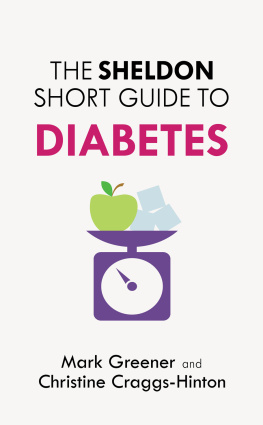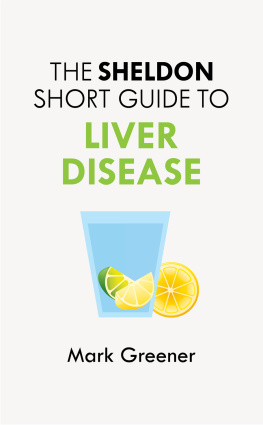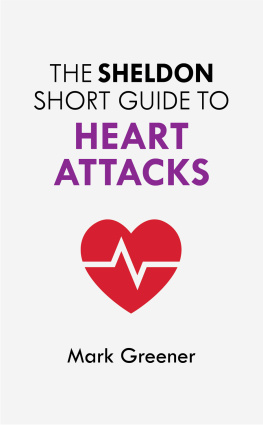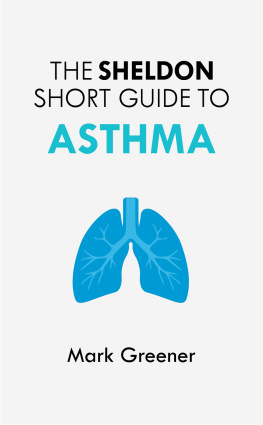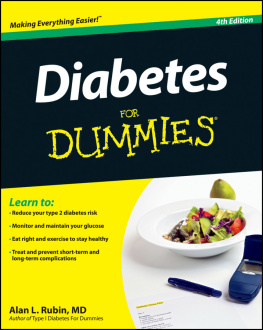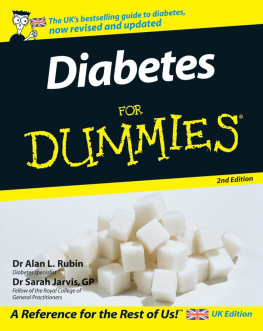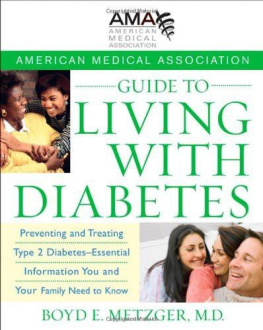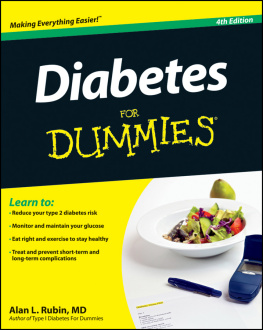
The Sheldon Short Guide to
Diabetes
Mark Greener spent a decade in biomedical research before joining MIMS Magazine for GPs in 1989. Since then, he has written on health and biology for magazines worldwide for patients, healthcare professionals and scientists. He is a member of the Royal Society of Biology and is the author of 21 other books, including The Heart Attack Survival Guide (2012) and The Holistic Health Handbook (2013), both published by Sheldon Press. Mark lives with his wife, three children and two cats in a Cambridgeshire village.
Christine Craggs-Hinton, mother of three, followed a career in the civil service until, in 1991, she developed fibromyalgia, a chronic pain condition. Christine took up writing for therapeutic reasons and produced more than a dozen books for Sheldon Press, including Living with Fibromyalgia , The Chronic Fatigue Healing Diet , Coping Successfully with Psoriasis and How to Manage Chronic Fatigue . She moved to the Canary Islands, where she became the resident agony aunt for a local newspaper and also took up fiction writing. Christine died in 2013.
Sheldon Short Guides
Asthma
Mark Greener
Depression
Dr Tim Cantopher
Diabetes
Mark Greener and Christine Craggs-Hinton
Heart Attacks
Mark Greener
Liver Disease
Mark Greener
Memory Problems
Dr Sallie Baxendale
Phobias and Panic
Professor Kevin Gournay
Stroke Recovery
Mark Greener
Worry and Anxiety
Dr Frank Tallis
THE SHELDON
SHORT GUIDE TO
DIABETES
Mark Greener and
Christine Craggs-Hinton

First published in Great Britain in 2016 by Sheldon Press
An Hachette UK Company
Sheldon Press
Carmelite House
50 Victoria Embankment
London EC4Y 0DZ
www.sheldonpress.co.uk
Copyright Mark Greener and the Estate of Christine Craggs-Hinton 2016
All rights reserved. No part of this book may be reproduced or transmitted in any form or by any means, electronic or mechanical, including photocopying, recording, or by any information storage and retrieval system, without permission in writing from the publisher.
The author and publisher have made every effort to ensure that the external website and email addresses included in this book are correct and up to date at the time of going to press. The author and publisher are not responsible for the content, quality or continuing accessibility of the sites.
British Library Cataloguing-in-Publication Data
A catalogue record for this book is available from the British Library
ISBN 9781847093837
To Yasmin, Rory, Ophelia and Rose, with love
This is not a medical book and is not intended to replace advice from your doctor. Consult your pharmacist, diabetes nurse or doctor if you believe you have any of the symptoms described, and if you think you might need medical help.
We used numerous medical and scientific papers to write the book that this Sheldon Short is based on: The Diabetes Healing Diet . Unfortunately, there isnt space to include references in this short summary. You can find these in The Diabetes Healing Diet, which discusses the topics in detail.
People living with diabetes have dangerously high blood sugar levels that poison their cells. Over several years, the raised levels of sugar can cause debilitating, distressing and disabling complications, such as pain, ulcers, amputations, heart disease and blindness. However, combining drugs, diet and other lifestyle measures could avoid most of these complications and may even reverse the early, gradual increase in blood glucose levels that ends in the most common form of diabetes. Even if youre taking medicines, a healthy, balanced diet increases your chances of avoiding diabetes-related damage, disability and death. This short book outlines the lifestyle changes and diet in particular that can help you tackle diabetes and live a fulfilled, active, satisfying life.
This book discusses general principles. It does not replace advice from your diabetes nurse, doctor or GP. They offer support tailored to your problems and circumstances. Rather, the book aims to support their expert advice. If you have any questions, speak to your diabetes team. Diabetes UK () is an invaluable source of advice and support. Never adjust or stop any medicine without speaking to your doctor or diabetes nurse.
In addition, everyone with diabetes should take part in structured education courses, which cover lifestyle, medications and monitoring blood glucose. For instance, DAFNE (Dose Adjustment For Normal Eating) and DESMOND (Diabetes Education and Self-Management for Ongoing and Newly Diagnosed Diabetes) help people with types 1 and 2 diabetes, respectively. Speak to your GP or diabetes team about local courses.
Cells are, essentially, biological factories. They use a sugar called glucose as fuel. We extract glucose from carbohydrates (such as sugars and starch) we eat and drink.
Carbohydrates are long chains of sugars. Starch, for example, consists of long chains of glucose. Sucrose (table sugar) contains glucose joined to another sugar called fructose. Digestion breaks carbohydrates into single sugars, carried around your body in your blood.
Insulin stimulates cells to take glucose from the blood. Without insulin, most cells cannot use glucose. So, blood glucose levels rise in people who do not produce enough insulin. Levels also rise if insulin does not work properly when it reaches the cells (insulin resistance).
High levels of glucose can cause serious damage. So, people with diabetes urinate more to flush the excess sugar out of the body and their urine tastes sweet. In 1674, Thomas Willis, a leading English doctor, used the sweet taste to distinguish diabetes from other diseases that caused frequent urination, such as infections or bladder stones. Willis coined the term diabetes mellitus the latter term from the Greek word for honey or sweet.
To understand why a healthy, balanced diet helps people with diabetes, we need to look at how the body normally controls blood sugar levels. Well begin with the pancreas.
The pancreas
The pancreas, which is about 15 cm (6 inches) long, lies behind your stomach (). Your pancreas has two vital roles, producing:
pancreatic juice, a cocktail of chemicals that helps you digest food, and
several important hormones, including insulin.
Pancreatic juice
Food travels from your mouth, down the food pipe (oesophagus) and into your stomach. Acid in the stomach sterilizes, and starts digesting, food. Food then flows into the duodenum ().
Specialized cells in the pancreas (acinar cells) pump pancreatic juice into small ducts. These feed into a larger channel running the length of the organ the pancreatic duct (). Meanwhile, the liver and gall bladder (a small pouch under the liver) release a greenish-yellow fluid called bile, which helps digest fats. The gall bladder stores bile. Bile flows along ducts from the liver and gall bladder. These join to form the common bile duct and enter the head of the pancreas. The common bile duct and pancreatic duct converge, then join the duodenum.
Islands in a pancreatic sea
When the nineteenth-century German medical student Paul Langerhans examined the pancreas under a microscope, he saw small, pale islands in a sea of acinar cells. We now know that these Islets of Langerhans produce hormones that control blood sugar levels.
Each of the million or so islets contains three major types of cell:
Beta cells produce insulin. The term insulin comes from the Latin for island: insula .
Next page
